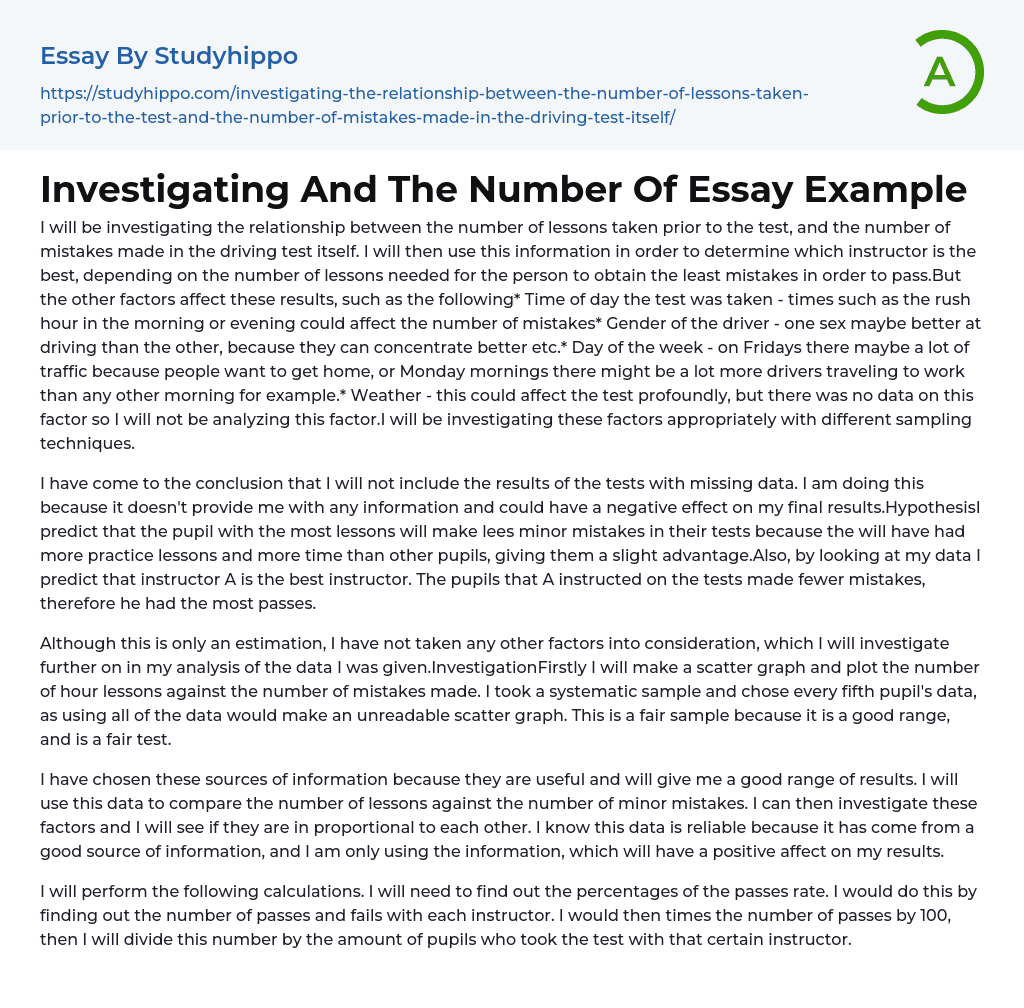The focus of my investigation is to analyze the impact of the number of lessons taken before a driving test on the number of mistakes made during the test. The objective is to identify the minimum amount of lessons required for passing with few errors and determining the best instructor based on that. However, there are several other factors that might affect my findings such as:
- The time of day when the test was conducted, particularly during rush hour periods which may result in more errors.
- The driver's gender could also play a role as one sex might have better concentration skills than others.
- Specific weekdays like Fridays or Monday mornings, which usually have more traffic and potential for errors.
- Since there is no data available, weather conditions will not be analyzed despite their influence on performance.
To
...evaluate these variables appropriately, I will employ suitable sampling techniques.
I have decided to exclude test results with missing data as they would not provide useful information and may negatively affect the final outcome. My hypothesis is that students who take more lessons will make fewer minor errors in tests due to additional practice and time allocation. Based on my analysis, I predict Instructor A to be the most effective instructor due to their students having fewer mistakes and a higher passing rate.
While this estimation only considers one aspect, further investigation will be conducted in my analysis of the provided data. My first step will be creating a scatter graph that displays the number of hour lessons versus the number of mistakes made. To prevent an unreadable scatter graph, I chose a systematic sample and used every fifth pupil's data. This
method is fair and provides a good range for analysis.
Because of their practicality and diverse outcomes, I selected these information sources to enable me to examine the relationship between minor errors and lesson frequency. The dependability of the data and its favourable effect on my conclusions provide me with assurance in its precision.
In order to calculate the pass rates for instructors, it is essential to determine the percentage of passes and failures. This computation requires multiplying the number of passes by 100 and dividing that outcome by the total number of students who took the test with that particular instructor.
Assessing the effectiveness of practice lessons on student success can be achieved by evaluating each instructor's success rate. To ensure accuracy, I will double-check my calculations and present the data using a visual pie chart. Moreover, an overall perspective of student performance with each instructor will be analyzed using a box plot.
By examining the graph, it is evident that there is no direct correlation between the quantity of lessons and minor mistakes made. Consequently, I deduce that another factor, the instructor, likely has an impact. To explore this, I will construct a graph that illustrates the relationship between mistakes made and lessons taken by each instructor, but instead of using the number of passes as a measure, I will employ pass percentage to ensure fairness since instructors evaluated varying numbers of students.
To investigate whether gender affects the frequency of errors, I examined their correlation and concluded that although there is no significant correlation, males have a higher pass rate than females. In particular, males have a pass rate of 56.8% compared to females' 40.6%.
I utilized a
box plot to demonstrate the driving test performance. Upon analyzing the graph, it is evident that pupils taught by Instructor A performed exceptionally well due to having the smallest interquartile ranges and range of results. However, the outcomes are positively skewed as they are clustered on the positive side of the box plot. This suggests that Instructor A's pupils performed the best, with all interquartile ranges falling within the 15 minor mistakes pass rate threshold. In contrast, Instructor B's pupils performed fairly well since most of the first interquartile lies within the 15 minor mistakes pass rate.
The pupils taught by Instructor C had varying results, with the largest interquartile range being 22 minor mistakes. The graph shows a relatively equal distribution between the number of passes and fails. The second interquartile is slightly above the passing threshold of 15, at 16.5 minor mistakes. In contrast, Instructor D's pupils fared poorly and are located in the negative range of the box plot.
On the other side of the spectrum from Instructor A's findings, the results shown in this box plot are heavily skewed towards poor performance and display the largest range of results, with the interquartile range being the second lowest. The breakdown of passes and fails is presented in pie charts.
- Research Methods essays
- Experiment essays
- Hypothesis essays
- Observation essays
- Qualitative Research essays
- Theory essays
- Explorer essays
- John Locke essays
- 9/11 essays
- A Good Teacher essays
- A Healthy Diet essays
- A Modest Proposal essays
- A&P essays
- Academic Achievement essays
- Achievement essays
- Achieving goals essays
- Admission essays
- Advantages And Disadvantages Of Internet essays
- Alcoholic drinks essays
- Ammonia essays
- Analytical essays
- Ancient Olympic Games essays
- APA essays
- Arabian Peninsula essays
- Argument essays
- Argumentative essays
- Art essays
- Atlantic Ocean essays
- Auto-ethnography essays
- Autobiography essays
- Ballad essays
- Batman essays
- Binge Eating essays
- Black Power Movement essays
- Blogger essays
- Body Mass Index essays
- Book I Want a Wife essays
- Boycott essays
- Breastfeeding essays
- Bulimia Nervosa essays
- Business essays
- Business Process essays
- Canterbury essays
- Carbonate essays
- Catalina de Erauso essays
- Cause and Effect essays
- Cesar Chavez essays
- Character Analysis essays
- Chemical Compound essays
- Chemical Element essays




